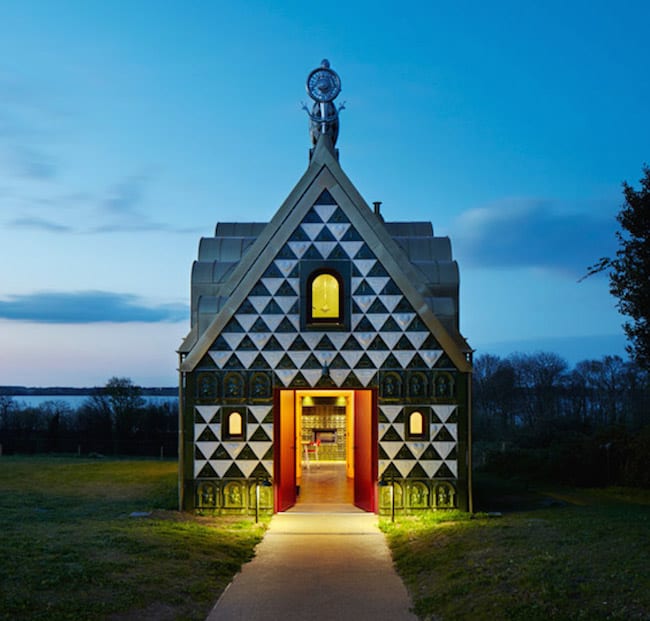You have until May 26 to enter a drawing for a stay in Grayson Perry and FAT Architecture’s “A House for Essex.” After years in development, Perry’s experiment that combines architecture with environmental storytelling is finally open.

The Wrabness home has been in the works for almost five years and is a collaboration with philosopher Alain de Botton’s Living Architecture program. The tiny holiday home is described by Grayson as a kind of tiled Taj Mahal for an ordinary (fictional) Essex woman, Julie Cope. Guests who stay at the home find themselves in a ceramic shrine to Cope, which covers her youth spent dating a guitarist in a local rock band, her divorce, her career in a comfortable government job and finally her death at the wheels of a delivery motorbike, which hangs ominously over the home’s foyer.
The word “kitsch” has been used to describe many of the home’s features, and they may be. But the loudness of each piece of art adorning the home stands out for the purposes of telling the story. Two saint-like paintings of Cope’s life act as a kind of Rosetta Stone for the major plot points. Supplemental materials, such as tile work, illustrate individual scenes from Cope’s life, building the character of this woman further. Grayson explains much of the story in his interviews with reporters, but I suspect that it could be pieced together without his help. Everything one needs is given prominence, and is then referenced in other works inside the home. One has only to explore long enough before the details start falling into place. The home rewards those who pay close attention.

Linearity is ignored in the narrative. One of the first works past the front door is a mosaic tile floor that tells us Cope is dead. The footprints in the eyes of the skull are where her second husband was standing when the police knocked on the door with the news of her demise. Linearity, such as having a mosaic commemorating Cope’s birth, would work against the story; linearity is a two-dimensional concept and Perry’s story is told in a three-dimensional space. In what a Channel 4 reporter called a story of “ordinary heroism” it makes more sense to relate these events in the rooms in which they occurred, not the order in which they occurred. Cope is gone, her husband is gone, but we’re rewarded with a close connection to each if we inhabit the same space they did in the key “plot points” of their life together. Their story is simple, but this closeness, this voyeurism, transgressing as an observer into someone else’s space sells it.
And, finally, there’s the story’s content. A woman was young once. She had a brief flirtation with a rock n’ roll lifestyle, but grew up to love a balding, slightly paunchy man with a job so mundane I’ve forgotten it already. They lived together, happily. They both put on a little weight as they got older. She died, as so many of us could die, in a dumb traffic accident, suddenly and without fanfare.

But, as mundane as her life was, her husband’s feet were seared into the floor when he learned he lost her. The chaff of her life in that moment was burned away, leaving paintings of herself that look like church windows. An icon of her presides over the foyer, arms outstretched, in a sign of serene acceptance. Tiles around the fireplace have the name “Julie” pressed into them again and again and again. The three-dimensional objects, with their arrangement and attendant volume, both tell of her simple life and make it holy.
Perry summarized it for the Channel 4 reporter:
“What you realize is that happiness is not this exotic peak of ecstasy. People think that happiness is over-adrenalized peaks of ecstasy and that happiness— most people are happiest with their friends and family, going out for a drink, walking the dog, hanging out. That’s what happiness is. It’s not bungee jumping. It’s not swimming with dolphins. It’s not getting married in a foreign country in a big castle. It’s, like, at home.”
This sentiment is sweet and authentic. It casts the lives of living, breathing people I know in a new light. This is literature, a poem, in 3D space.
Bill Rodgers is a Contributing Editor at CFile
Any thoughts about this post? Share yours in the comment box below.











Photographs by Jack Hobhouse

Grayson Perry

Add your valued opinion to this post.